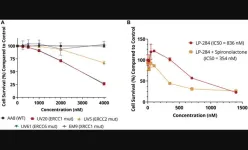(Press-News.org) T2D patients with lower birthweight also show higher use of diabetes drugs than those with normal birthweight, and a larger number of comorbidities including high blood pressure, at the time of diagnosis.
The first study is by Dr Rasmus Wibaek, Steno Diabetes Center Copenhagen, Herlev, Denmark, and Dr Allan Vaag, Steno Diabetes Center Copenhagen, and also Lund University, Malmö, Sweden, and colleagues.
This study included adults aged 30–60 years enrolled in the Danish Inter99 cohort in 1999–2001 (baseline examination), with information on birthweight from original birth records from 1939–1971 and without diabetes at baseline. Birth records were linked with individual-level data on age at diabetes diagnosis. Incidence rates of T2D by age, sex and birthweight were estimated using statistical modelling, adjusting for prematurity status at birth, birth order (position in the birth order among any sibilings), genetic risk scores for birthweight and type 2 diabetes, maternal and paternal diabetes history, socioeconomic status and adult body mass index (BMI).
The authors found that, among 4590 participants, there were 492 incident T2D cases during an average follow-up of 19 years. T2D incidence rate increased with age, was higher in male participants, and decreased linearly with increasing birthweight, with each extra kg of birthweight linked to a 40% reduced risk of T2D, which continued into the highest birthweights. Notably, the absolute rate of increase in T2D incidence across age was markedly steeper in persons born with lower birth weights compared with higher birth weights.
The findings suggest that the effect of birth weight on type 2 diabetes risk is distinct and independent of genetic susceptibility to T2D and adult adiposity, and that low birth weight as a proxy of an adverse fetal environment is of similar aetiological importance to that of genotype.
The second study, also by Dr Vaag and first author Dr Aleksander L. Hansen of the Steno Diabetes Center Copenhagen, and colleagues, analysed midwife records for 6866 individuals with T2D in the Danish Centre for Strategic Research in type 2 diabetes cohort.
They assessed age at diagnosis, anthropomorphic measures (body dimensions), comorbidities, medications, metabolic variables, and family history of T2D in individuals with the lowest 25% of birthweight (<3000 g) and highest 25% of birthweight (>3700 g), compared with a birthweight of 3000–3700 g as reference (the middle 50% of birthweights 25%-75%), using statistical modelling. Continuous relationships across the entire birthweight spectrum were also assessed. Weighted polygenic scores (PS) for type 2 diabetes and birthweight were calculated to assess the impact of genetic predispositions.
Each 1 kg decrease in birthweight was associated with a 3.3 year younger age of diabetes onset, 1.5 kg/m2 lower BMI and 3.9 cm smaller waist circumference. Compared with the reference birthweight, a birthweight of <3000 g was associated with more overall comorbidity, with a 36% higher chance of having 3 or more comorbidities and a 26% higher chance of having a systolic blood pressure above 155 mm Hg (severe hypertension).
Compared with birthweight 3000–3700 g (the average birthweight in Denmark being around 3.4kg), birthweight <3000 g was associated with younger age at type 2 diabetes diagnosis. The authors found those with low birthweight had a 28% increased risk of being diagnosed with T2D aged under 45 years (more likely to be diagnosed younger), and a 30% lower risk of being diagnosed aged over 75 years (less likely to be diagnosed older).
Birthweight under 3kg was associated with reporting fewer individuals with a family history of type 2 diabetes, with a slight (7%) increased chance of reporting no type 2 diabetes-affected relatives, but a 33% reduced risk of reporting three or more relatives with type 2 diabetes. Similarly, birthweight under 3kg was associated with a lower BMI, with a 12% increased chance of being in the normal weigh category (BMI <25 kg/m2), decreasing to a 43% reduced risk of having severe obesity (BMI above 40). The associations between birthweight and adult BMI, were completely linear across the entire birthweight spectrum.
Other factors linked to a lower birthweight were a lower prevalence of diabetes-associated neurological disease and a 33% increased risk of using of three or more glucose-lowering drugs.
Clinically defined low birthweight (below 2.5kg) yielded stronger associations, and a higher birthweight was associated with characteristics mirroring lower birthweight in opposite directions. This in full agreement with the observed linear associations between birthweights and most relevant clinical outcomes.
The authors say: “Taken together, the two studies collectively provide strong support for the following conclusions: an adverse fetal environment reflected by low birthweight is a strong and non-genetic risk factor not only of developing type 2 diabetes per se, but in addition for the development of a relatively more severe subtype of type 2 diabetes - with earlier disease onset, more complications, and co-morbidities, as well as with an increased need for clinical care and medical treatments.
“The impact of low birthweight appears independent to that of genetics and obesity, which is why people with low birthweight are at a relatively increased risk for type 2 diabetes for any given increase in BMI. This, in turn, explains the finding of a lower BMI in low birthweight subjects at the time of type 2 diabetes onset. Low birthweight should therefore be considered as a criteria for screening for type 2 diabetes with same importance as that of a positive family history of diabetes. Notably, as the study by Wibaek et al. indicates, neither people with a lower birth weight, nor those with a high genetic risk of type 2 diabetes are actually at a particularly very high absolute risk of developing type 2 diabetes if they are able to keep a normal BMI throughout their lives. Finally, within the era of precision medicine, low birthweight holds the potential to be used as a marker to guide clinical care and treatment in type 2 diabetes.”
END
Low birthweight is independently linked to increased risk of type 2 diabetes, and a particular presentation including lower age at diagnosis
Among newly diagnosed patients with type 2 diabetes, lower birthweight is associated with younger age, lower prevalence of obesity, and fewer individuals with a family history of type 2 diabetes
2023-06-13
ELSE PRESS RELEASES FROM THIS DATE:
Gentle cleansers kill viruses as effectively as harsh soaps, study finds
2023-06-13
Gentle cleansers are just as effective in killing viruses – including coronavirus – as harsh soaps, according to a new study from scientists at the University of Sheffield
Healthcare professionals often substitute alcohol-based hand sanitisers and harsh soaps for skin-friendly cleansers in order to treat or prevent irritant contact dermatitis, which develops when chemical or physical agents damage the skin surface faster than the skin can repair
Incidence and severity of irritant contact dermatitis increased from 20 per cent to 80 per cent amongst healthcare professionals during the Covid-19 pandemic
Researchers also found non-enveloped ...
LP-284 targets non-Hodgkin's lymphoma and DNA damage repair deficiency
2023-06-12
“[...] we demonstrated the new acylfulvene compound LP-284 has anti-tumor activity including nanomolar potency in fifteen in vitro NHL cell lines and in vivo preclinical NHL models.”
BUFFALO, NY- June 12, 2023 – A new research paper was published in Oncotarget's Volume 14 on June 12, 2023, entitled, “LP-284, a small molecule acylfulvene, exerts potent antitumor activity in preclinical non-Hodgkin's lymphoma models and in cells deficient in DNA damage repair.”
Despite advances in therapies treating non-Hodgkin’s ...
Damon Runyon Cancer Research Foundation announces three recipients of 2023 Physician-Scientist Training Award
2023-06-12
Three scientists with exceptional promise and novel approaches to fighting cancer have been named the 2023 recipients of the Damon Runyon Physician-Scientist Training Award. The awardees were selected through a highly competitive and rigorous process by a scientific committee comprised of leading cancer researchers who are themselves physician-scientists.
Physician-scientists are uniquely positioned to translate scientific discoveries into therapies that improve and prolong the lives of their patients. However, ...
Where there’s smoke are lessons in demands of global sustainability
2023-06-12
As the world struggles for sustainability in the face of climate change, wildfire smoke becomes a lesson in how people can become victims far from the root of a problem and far from their control.
In this month’s open access National Science Review, Jianguo “Jack” Liu, MSU Rachel Carson Chair in Sustainability, makes a case for the world to shake off the constraints of traditional governance, which tends to address issues in one place without considering how people or ecologies near and far might be impacted.
Justice at a global scale can be threatened when natural events or human decisions in one part of the world to protect, reroute, ...
Dartmouth-led project updates smoking as a risk factor in NCI mortality estimates
2023-06-12
New findings from a project led by researchers at Dartmouth’s Geisel School of Medicine in collaboration with the National Cancer Institute (NCI) and published in the journal JAMA Network Open, show the dramatic impact that smoking status has on mortality and more accurately predict the risk of dying from cancer and other diseases.
“Historically, mortality risk has often been presented by age, sex, and race but it rarely has accounted for smoking status—a major risk factor for many causes of death,” says lead author Steven Woloshin, MD, MS, a professor of ...
Victor J. Torres, Ph.D., named chair of newly formed Department of Host-Microbe Interactions at St. Jude Children’s Research Hospital
2023-06-12
(MEMPHIS, Tenn., June 12, 2023) St. Jude Children’s Research Hospital today announced that Victor J. Torres, Ph.D., an internationally renowned microbiologist and immunologist has been selected as the inaugural chair of a new Department of Host-Microbe Interactions. This department will establish a world-leading effort focused on exploring the fundamental biology of the interaction of infectious agendas with the human host. The discoveries made through this new effort will advance our ability to more effectively treat, as well as prevent infectious diseases
“Infectious diseases remain one of the leading causes of death globally for children under the age of five,” ...
Digital divide hinders rural innovation, study shows
2023-06-12
UNIVERSITY PARK, Pa. — Cloud-based computing directly contributes to business innovation, but rural businesses lacking sufficient broadband capacity to access cloud services are missing out on their innovation-boosting potential, according to a team of researchers from Penn State and the National Science Foundation. The findings can be used by policymakers and business-support organizations to foster greater opportunities for rural innovation.
“Innovation plays a critical role in keeping businesses competitive and viable, and in turn, healthy businesses are essential to vibrant rural economies. Therefore, we’re interested ...
Penile HIV infection is effectively prevented by antiretroviral treatment
2023-06-12
Of the 38 million people worldwide living with HIV, approximately 700,000 are newly infected men, primarily via sexual transmission. Sexually transmitted HIV infections in exclusively heterosexual men are acquired through the penis. In addition, semen which is produced in the male genital tract (MGT) has been recognized as the primary vector for vaginal and rectal HIV transmission. Notably, the risk of sexual HIV transmission increases with the presence of a concurrent sexually transmitted infection.
For the majority of patients, antiretroviral therapy (ART) rapidly decreases the viral load in blood and semen, ...
Breakthrough in glioblastoma treatment with the help of a virus
2023-06-12
In a recently published manuscript, Howard Colman, MD, PhD, Jon M. Huntsman Presidential Professor of Neuro-Oncology and co-leader of the Neurologic Cancers Disease Center and the Experimental Therapeutics CCSG program at Huntsman Cancer Institute, identified a potential breakthrough in glioblastoma treatment.
Glioblastoma, or GBM, is an aggressive type of brain cancer. According to Colman, this is the most common type of cancerous brain tumor in adults. Standard treatments include radiation and chemotherapy. Unfortunately, typical GBM tumors are often resistant ...
AMA strengthens its policy on protecting access to gender-affirming care
2023-06-12
CHICAGO—The American Medical Association (AMA) House of Delegates today passed the Endocrine Society’s resolution to protect access to evidence-based gender-affirming care for transgender and gender-diverse individuals.
As political attacks on gender-affirming care escalate, it is the responsibility of the medical community to speak out in support of evidence-based care. Medical decisions should be made by patients, their relatives and health care providers, not politicians.
In the resolution, the AMA committed to opposing any criminal and legal penalties against patients seeking ...
LAST 30 PRESS RELEASES:
UVA’s Jundong Li wins ICDM’S 2025 Tao Li Award for data mining, machine learning
UVA’s low-power, high-performance computer power player Mircea Stan earns National Academy of Inventors fellowship
Not playing by the rules: USU researcher explores filamentous algae dynamics in rivers
Do our body clocks influence our risk of dementia?
Anthropologists offer new evidence of bipedalism in long-debated fossil discovery
Safer receipt paper from wood
Dosage-sensitive genes suggest no whole-genome duplications in ancestral angiosperm
First ancient human herpesvirus genomes document their deep history with humans
Why Some Bacteria Survive Antibiotics and How to Stop Them - New study reveals that bacteria can survive antibiotic treatment through two fundamentally different “shutdown modes”
UCLA study links scar healing to dangerous placenta condition
CHANGE-seq-BE finds off-target changes in the genome from base editors
The Journal of Nuclear Medicine Ahead-of-Print Tip Sheet: January 2, 2026
Delayed or absent first dose of measles, mumps, and rubella vaccination
Trends in US preterm birth rates by household income and race and ethnicity
Study identifies potential biomarker linked to progression and brain inflammation in multiple sclerosis
Many mothers in Norway do not show up for postnatal check-ups
Researchers want to find out why quick clay is so unstable
Superradiant spins show teamwork at the quantum scale
Cleveland Clinic Research links tumor bacteria to immunotherapy resistance in head and neck cancer
First Editorial of 2026: Resisting AI slop
Joint ground- and space-based observations reveal Saturn-mass rogue planet
Inheritable genetic variant offers protection against blood cancer risk and progression
Pigs settled Pacific islands alongside early human voyagers
A Coral reef’s daily pulse reshapes microbes in surrounding waters
EAST Tokamak experiments exceed plasma density limit, offering new approach to fusion ignition
Groundbreaking discovery reveals Africa’s oldest cremation pyre and complex ritual practices
First breathing ‘lung-on-chip’ developed using genetically identical cells
How people moved pigs across the Pacific
Interaction of climate change and human activity and its impact on plant diversity in Qinghai-Tibet plateau
From addressing uncertainty to national strategy: an interpretation of Professor Lim Siong Guan’s views
[Press-News.org] Low birthweight is independently linked to increased risk of type 2 diabetes, and a particular presentation including lower age at diagnosisAmong newly diagnosed patients with type 2 diabetes, lower birthweight is associated with younger age, lower prevalence of obesity, and fewer individuals with a family history of type 2 diabetes


